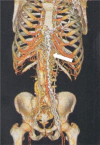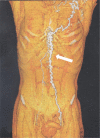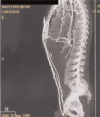The first reported case of factor V Leiden mutation with agenesis of superior vena cava: A case report
- PMID: 29851773
- PMCID: PMC6392798
- DOI: 10.1097/MD.0000000000010511
The first reported case of factor V Leiden mutation with agenesis of superior vena cava: A case report
Abstract
Rationale: Total absence of superior vena cava (ASVC) is a very rare anomaly, and the patient usually suffers from superior vena cava syndrome (SVCS) or conduction disturbances.
Patient concerns: We report a 36-year-old white male, born and living in Brazil, without comorbidities presented to hematologist thrombotic episodes even under anticoagulant therapy. On his first hematologic appointment, he had no active complaints except by the fullness after meals, and his physical examination presented remarkable collateral circulation in the chest.
Diagnoses: Congenital ASVC associated with factor V Leiden mutation.
Outcomes: In his magnetic resonance angiography of the thorax, a great amount of collateral circulation and communication of the azygos and hemiazygos veins with inferior vena cava were evident, as well as the absence of the upper cava vein. Furthermore, heterozygous genetic mutation was found for Leiden factor V.
Lessons: This case gives us the lesson that we need to include ASVC in the differential diagnosis of SVCS. The importance of the V-Leiden factor as a joint risk with this congenital defect for venous thromboembolism episodes was also highlighted.
Conflict of interest statement
The authors report no conflicts of interest.
Figures









References
-
- Sfyroeras GS, Antonopoulos CN, Mantas G, et al. A review of open and endovascular treatment of superior vena cava syndrome of benign aetiology. Eur J Vasc Endovasc Surg 2017;53:238–54. - PubMed
-
- Granata A, Andrulli S, Fiorini F, et al. Persistent left superior vena cava: what the interventional nephrologist needs to know. J Vasc Access 2009;10:207–11. - PubMed
Publication types
MeSH terms
Substances
LinkOut - more resources
Full Text Sources
Other Literature Sources
Medical

